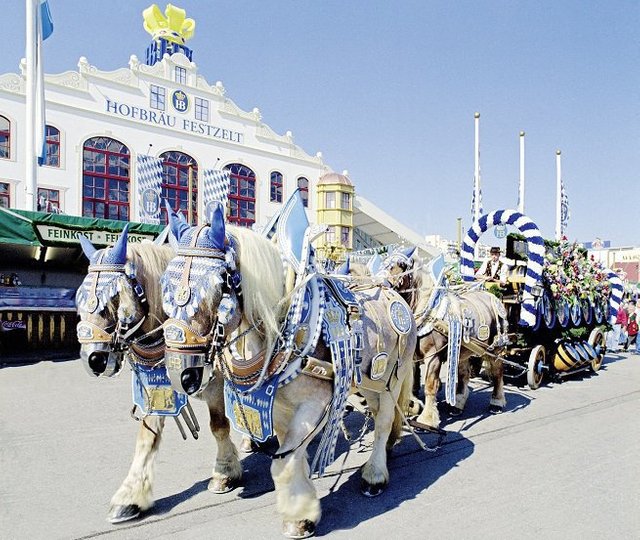The Oktoberfest is the beer festival par excellence and has been held in Munich every September for over 200 years. his is the history of the world's most famous brewing event.

Rarely has a royal wedding given rise to a century-old tradition that is celebrated every year by millions of people around the world. The origins of the Oktoberfest, or October holiday as it could be translated from German, go back to the early 19th century, specifically to 12 October 1810, when Prince Louis of Bavaria, son of King Maximilian I, married Teresa of Saxony-Hildburghausen in Munich. The festivities lasted five days, until 17 October, and the inhabitants of the city were invited to take part in them in a meadow outside the city wall, and were later called Theresenwiese, in honour of the queen consort of Bavaria.
That first celebration was little like the celebration of the current beer, in fact it did not even revolve around this drink, but the main event of the celebrations was a horse race held on the last of the five days. This event was very well received and it was decided to repeat the event the following year, originating this long tradition that has been cancelled only twenty times during these more than 200 years of history, mainly due to epidemics or warlike conflicts. However, it was not until the 1818 edition that the typical barracks were introduced, later replaced by tents and beer and food stands that have become the symbol par excellence of this festivity. In fact, the owners of the breweries in Munich did not begin to take an active part in the celebrations until 1887.
Obviously, many things have changed since the first edition up to now, in addition to the introduction of beer as a main element, although the Oktoberfest is still being held in the same fields as in 1810, now in the heart of the city, next to the central station, München Hauptbahnhof, due to the huge growth of the city. Now it not only attracts millions of visitors every year who consume as many litres of beer as it is in the Bavarian capital, but it is one of Germany's biggest tourist attractions.

To date, the dates of its celebration have been slightly advanced to take advantage of the best weather conditions of late summer. Thus, it always starts at 12 noon on the first Saturday after 15 September, with the opening of the first beer barrel in the Schottenhammel tent by the Mayor of Munich at the shout of O' zapft is and followed by the 12 barrel barrels which indicate that the other tents can start serving beer to the attendees. The festival lasts for 16,17 or 18 days depending on the calendar of the current year, ensuring that it always lasts until at least 3 October, the German Unity Day commemorating the reunification of 1990.
And although it is known worldwide as the beer festival par excellence in Europe, the festival goes far beyond beer consumption. It is a socio-cultural event with parades of typical regional costumes, live music, fairground attractions and countless Bavarian food stalls serving the famous würstl, brezen or knödel, as well as typical dishes of beef, chicken and fish. It is also a very familiar event, where every year the Bavarians wear their best outfits and take out their dirndl, the typical women's dress, or their lederhosen, the leather trousers that men wear. Or haven't you seen the typical images of Bayern Munich players wearing their leather trousers, knee-high stockings and felt hats toasting with their typical Maß pitchers?
Oktoberfest Beers
Even if millions of liters of this nectar are consumed during this party, don't think it's worth any kind of beer. In fact, only one type of beer known as Oktoberfestbier, an appellation of origin that includes only those beers brewed within the city limits of Munich and which comply strictly with the German Purity Act of 1516 or Reinheitsgebot, is served in the festival's tents, produced with only four ingredients such as water, malt, hops and yeast.

These Oktoberfestbiers are all märzen style, low-fermentation lager beers produced during spring, especially in March (hence their name), and matured during the hottest summer months, for consumption during the autumn harvest season, just in time for the festival. Not all beers of this style are the same, but there are from blond to more toasted, although with an alcoholic graduation always around 6%, something more than the usual beers. That said, there are only six breweries in Munich that meet the standards required to produce the official beers for this event:
The Oktoberfest in numbers
To better understand the magnitude of the German beer festival, we need to take a look at some statistical data published every year by the organizers of the event. Numbers that are surpassed with each new edition, leaving obsolete those of previous years:
This is the place i need to be. Last time i was in germany, i luved paulaner
Downvoting a post can decrease pending rewards and make it less visible. Common reasons:
Submit